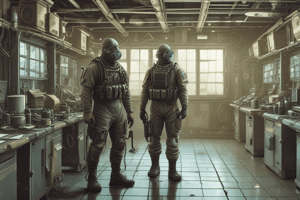Podcast
Questions and Answers
What is the primary effect of vesicant agents on the body?
What is the primary effect of vesicant agents on the body?
- Immediate harm to the respiratory tract
- Formation of burn-like blisters on the skin (correct)
- Depletion of the body's ability to reproduce white blood cells
- Damage to lung tissue
What is the characteristic of persistent or nonvolatile agents?
What is the characteristic of persistent or nonvolatile agents?
- They cause immediate harm to lung tissue
- They mutate and damage cellular DNA
- They remain on surfaces for longer than 24 hours (correct)
- They evaporate quickly
What is the route of exposure that determines how sulfur mustard enters the body?
What is the route of exposure that determines how sulfur mustard enters the body?
- Inhalation of vapor
- Direct contact with the skin (correct)
- Ingestion of contaminated food
- Indirect contact with contaminated surfaces
What is the effect of sulfur mustard on the body's ability to reproduce white blood cells?
What is the effect of sulfur mustard on the body's ability to reproduce white blood cells?
What is the characteristic of respiratory agents?
What is the characteristic of respiratory agents?
What is the effect of vesicant exposure on the skin?
What is the effect of vesicant exposure on the skin?
What is a characteristic of chlorine when released?
What is a characteristic of chlorine when released?
How do V-agents, such as VX and VR, affect the body?
How do V-agents, such as VX and VR, affect the body?
What is the primary way that nerve agents cause fatalities?
What is the primary way that nerve agents cause fatalities?
What is a characteristic of biologic agents?
What is a characteristic of biologic agents?
What is a characteristic of botulin toxin?
What is a characteristic of botulin toxin?
What is a characteristic of viral hemorrhagic fevers, such as Ebola and yellow fever?
What is a characteristic of viral hemorrhagic fevers, such as Ebola and yellow fever?
Flashcards are hidden until you start studying
Study Notes
- Chemical agents can be described as liquid, gas, or solid materials with varying persistency and volatility, which affect how long they stay on surfaces before evaporating.
- Persistent or nonvolatile agents remain on surfaces for longer than 24 hours, while non-persistent or volatile agents evaporate quickly.
- The route of exposure determines how the agent enters the body, with vapor hazards entering the respiratory tract and contact hazards entering through the skin.
- Vesicant agents, also known as blister agents, primarily affect the skin and cause burn-like blisters to form, with the most damage occurring in moist areas like the armpits, groin, and respiratory tract.
- Signs of vesicant exposure include skin irritation, burning, and intense pain, as well as the formation of large blisters and gray discoloration of the skin.
- Sulfur mustard is a persistent, brown-yellow oily substance with a garlic-like smell that mutates and damages cellular DNA, leading to cell death.
- It attacks cells within bone marrow and depletes the body's ability to reproduce white blood cells, with no antidotes available for treatment.
- Respiratory agents, also known as choking agents, are gases that cause immediate harm and damage to lung tissue, producing symptoms like dyspnea, tachypnea, and pulmonary edema.
- Chlorine has a distinct bleach-like odor and creates a green haze when released, initially causing upper airway irritation and later producing shortness of breath, chest tightness, and other symptoms.
- Phosgene is a potent agent with a delayed onset of symptoms, producing a smell similar to freshly cut grass or hay, and initially causing nausea, chest tightness, and coughing.
- Nerve agents are extremely toxic and rapidly fatal, causing cardiac arrest within seconds to minutes of exposure, and can block essential enzymes in the nervous system.
- G-series agents, including sarin, soman, and tabun, are highly lethal and have different levels of persistency, volatility, and symptoms.
- V-agents, including VX and VR, are clear oily agents with no odor, remaining relatively unchanged for weeks to months and being easily absorbed into the skin.
- Nerve agent treatment focuses on providing airway and ventilatory support, as fatalities occur due to respiratory complications.
- Metabolic agents, including hydrogen cyanide and cyanogen chloride, affect the body's ability to use oxygen, causing rapid cellular death and symptoms like dizziness, lightheadedness, and headache.
- Biologic agents are grouped into viruses, bacteria, and neurotoxins, and are spread through various means, including decimation, vectors, and direct contact.
- Viruses require a living host to multiply and survive, invading healthy cells and replicating themselves to spread through the host.
- Viral hemorrhagic fevers, such as Ebola and yellow fever, cause blood to seep out from tissues and blood vessels, initially producing flu-like symptoms that progress to more serious symptoms.
- Bacteria can be treated with antibiotics and often begin with flu-like symptoms, with the bubonic plague infecting the lymphatic system and the pneumonic plague being a lung infection.
- Neurotoxins are the deadliest substances known to humans, produced from plants, marine animals, molds, and bacteria, and have a fast onset of symptoms, including botulin toxin and ricin.
- Botulin toxin is the most potent neurotoxin, affecting the nervous system's ability to function, and ricin causes pulmonary edema and respiratory and circulatory failure.
Studying That Suits You
Use AI to generate personalized quizzes and flashcards to suit your learning preferences.




